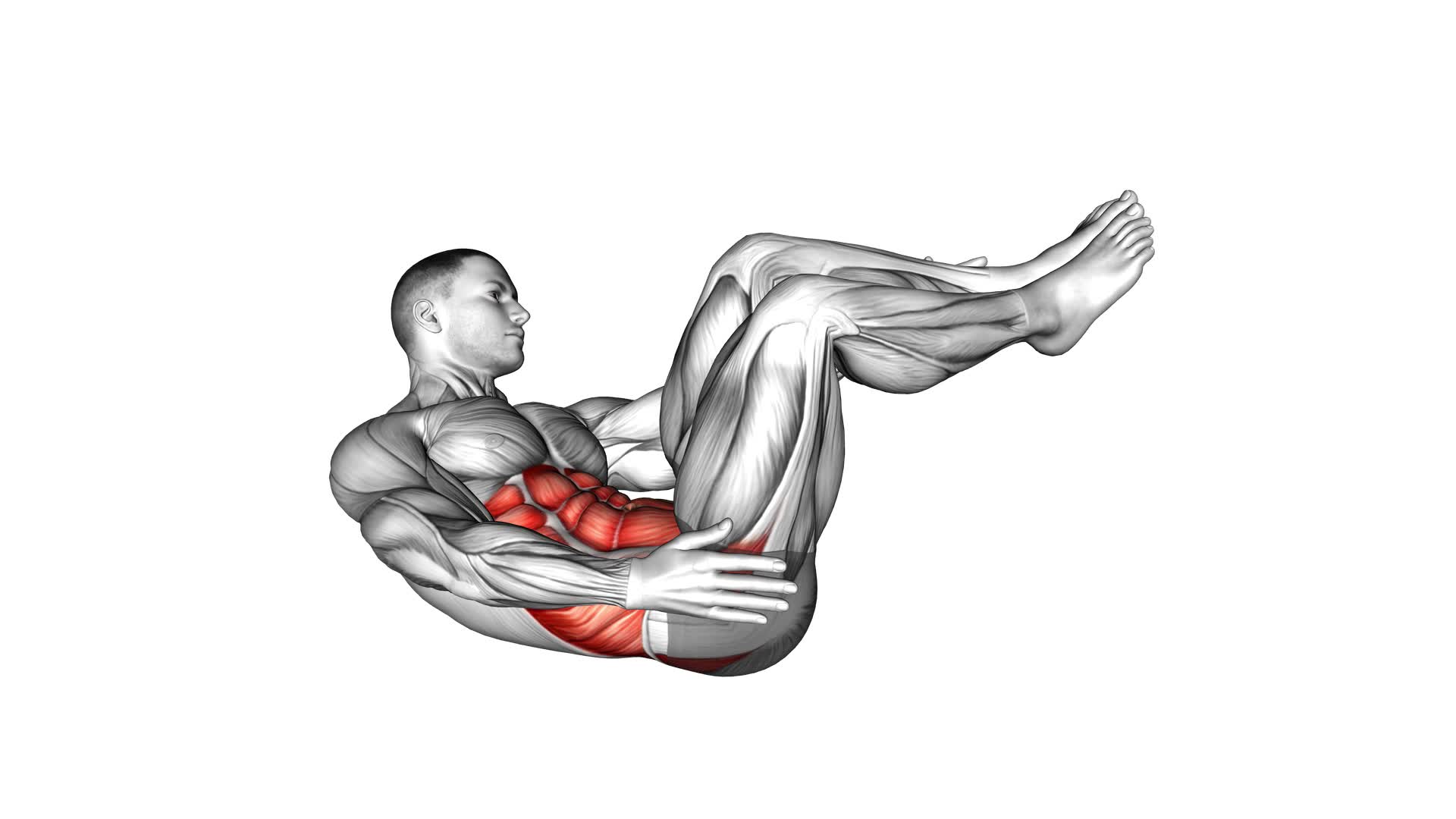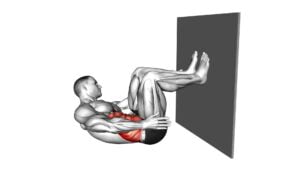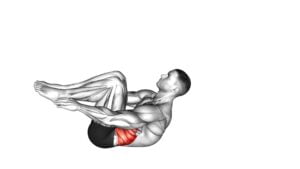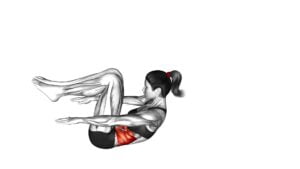90 Degree Heel Touch (male) – Video Exercise Guide & Tips

In this video exercise guide, you'll learn how to master the 90 degree heel touch.
Watch This Exercise Video
This exercise offers numerous benefits, such as strengthening your core and improving flexibility.
With just a few simple steps, you'll be able to perform this exercise effectively and avoid common mistakes.
Plus, we'll share tips to increase the intensity and challenge for those looking to take it up a notch.
Get ready to elevate your fitness routine with the 90 degree heel touch!
Key Takeaways
- The 90 Degree Heel Touch exercise strengthens core muscles, improves stability and balance, and helps maintain proper posture and reduce lower back pain.
- It increases flexibility and range of motion in the torso, targets abdominal muscles, obliques, and lower back, and enhances balance and stability.
- The exercise can be done anywhere, without the need for any equipment, making it convenient for those who prefer bodyweight exercises.
- Proper technique and body alignment are essential to prevent injuries and ensure a safe and effective workout.
Benefits of the 90 Degree Heel Touch
Discover the numerous benefits you can experience by incorporating the 90 Degree Heel Touch exercise into your fitness routine. This simple yet effective exercise targets your core muscles, specifically your obliques, and offers a range of benefits for your overall fitness and well-being.
One of the main benefits of the 90 Degree Heel Touch is its ability to strengthen your core. By engaging your oblique muscles, this exercise helps to improve your stability and balance. Strong core muscles are essential for maintaining proper posture and reducing the risk of lower back pain.
Additionally, the 90 Degree Heel Touch can help to improve your overall flexibility. As you reach towards your heels, you're stretching and elongating your oblique muscles. Regularly performing this exercise can lead to increased flexibility and range of motion in your torso.
Furthermore, the 90 Degree Heel Touch can be modified to suit different fitness levels and abilities. For beginners, you can start by bending your knees slightly or reducing the range of motion. As you become more comfortable and stronger, you can gradually increase the difficulty by straightening your legs or reaching further towards your heels.
Incorporating the 90 Degree Heel Touch into your fitness routine not only provides numerous benefits for your core strength and flexibility, but it also offers the flexibility for modifications to suit your individual needs and goals.
Equipment Needed for the Exercise
To perform the 90 Degree Heel Touch exercise, you'll only need a yoga mat or a comfortable surface to lie on. This simple equipment option makes it easy to do the exercise anywhere, whether you're at home or at the gym. The yoga mat provides a cushioned and non-slip surface, ensuring that you can maintain stability while performing the exercise.
If you don't have access to a yoga mat, don't worry. You can still do the 90 Degree Heel Touch on any comfortable surface, such as a carpet or a towel. Just make sure that the surface is clean and free from any objects that could cause discomfort or hinder your movement.
In terms of alternative exercises, there are a few options that target similar muscle groups as the 90 Degree Heel Touch. One alternative is the Russian Twist, which also focuses on the abdominal muscles and obliques. Another option is the Reverse Crunch, which targets the lower abs. Both of these exercises can be done without any equipment, making them convenient for those who prefer bodyweight exercises.
Step-By-Step Guide on How to Perform the 90 Degree Heel Touch
Let's now go over the key points to keep in mind when performing the 90 Degree Heel Touch exercise.
- First, make sure to place your hands on the floor beside your hips to maintain stability throughout the movement.
- It's important to avoid common mistakes such as lifting your shoulders or rounding your back.
- By incorporating heel touches into your workout routine, you can strengthen your core, improve balance, and enhance overall body control.
Hand Placement for Stability
Place your hands firmly on the ground to ensure stability while performing the 90 Degree Heel Touch exercise. Proper hand placement is crucial for maintaining balance and preventing injury during this exercise. Follow these steps to achieve the correct hand position:
- Start in a push-up position with your hands slightly wider than shoulder-width apart.
- Keep your fingers spread wide and press your palms firmly into the ground.
- Engage your core muscles and distribute your weight evenly between your hands and feet.
By placing your hands in the correct position, you create a strong foundation for the exercise, allowing you to focus on the movement of your legs and maintaining proper form.
Now that you have a solid hand placement, let's move on to the next section where we'll discuss common mistakes to avoid.
Common Mistakes to Avoid
Avoid bending your elbows too much during the 90 Degree Heel Touch exercise. This is a common mistake that can lead to injury and improper body alignment. To prevent injury and ensure proper body alignment, it's important to keep your elbows slightly bent and close to your sides throughout the exercise.
This will help engage your core muscles and maintain stability. Additionally, be mindful of your posture and avoid rounding your shoulders or hunching forward. Keep your chest lifted and your spine neutral.
Benefits of Heel Touches
To perform the 90 Degree Heel Touch, you'll engage your core muscles while reaching for your heels. This exercise offers several benefits for core strengthening and overall fitness. Here are some of the advantages:
- Improved core strength: The 90 Degree Heel Touch targets your abdominal muscles, obliques, and lower back, helping to strengthen and tone these areas.
- Increased flexibility: By reaching for your heels, you engage your hip flexors and improve their flexibility.
- Enhanced balance and stability: This exercise requires you to maintain a stable position while moving your legs, which helps improve balance and stability.
To maximize the benefits of the 90 Degree Heel Touch, it's essential to incorporate proper breathing techniques. Remember to exhale as you reach for your heels and inhale as you return to the starting position. This helps engage your core muscles and maintain control throughout the exercise.
Now, let's move on to the next section and discuss common mistakes to avoid during the exercise.
Common Mistakes to Avoid During the Exercise
To ensure the effectiveness and safety of the degree heel touch exercise, it's important to avoid common mistakes. Incorrect form can lead to dangers and potential injuries.
To prevent this, focus on proper body alignment techniques and follow injury prevention tips.
Incorrect Form Dangers
When performing the Degree Heel Touch exercise, be mindful of the common mistakes that can lead to incorrect form and potential dangers. It's crucial to understand the dangers of incorrect form and the importance of proper technique to ensure a safe and effective workout.
Here are some common mistakes to avoid:
- Rounding your back: This can strain your lower back and lead to injury. Keep your back straight throughout the exercise.
- Using momentum: Swinging your legs instead of using your abdominal muscles reduces the effectiveness of the exercise and can strain your hip flexors.
By avoiding these mistakes, you can maximize the benefits of the Degree Heel Touch exercise while minimizing the risk of injury.
Now, let's move on to the next section where we'll discuss injury prevention tips to further enhance your safety during this exercise.
Injury Prevention Tips
To prevent injury during the Degree Heel Touch exercise, focus on maintaining proper form and avoiding common mistakes.
Injury prevention techniques are essential to ensure a safe and effective workout. Before starting the exercise, it's crucial to warm up your body with dynamic stretches and movements. This helps to increase blood flow, loosen up muscles, and prepare your body for the workout ahead.
Additionally, make sure to engage your core muscles throughout the exercise to provide stability and protect your lower back. Avoid jerking or using excessive force, as this can strain your muscles and joints.
It's also important to listen to your body and stop if you feel any pain or discomfort. By following these injury prevention tips, you can enjoy the benefits of the Degree Heel Touch exercise while minimizing the risk of injury.
Proper Body Alignment Techniques
You need to ensure proper body alignment during the Degree Heel Touch exercise to avoid common mistakes that can lead to injury. Body alignment is of utmost importance as it ensures that your muscles are working efficiently and effectively.
Here are some key techniques to maintain proper body alignment during the exercise:
- Keep your head and neck in a neutral position, avoiding any excessive tilting or straining.
- Engage your core muscles by pulling your belly button towards your spine, maintaining a stable and strong midsection.
- Demonstrate proper technique by keeping your shoulders relaxed and down, away from your ears.
- Maintain a straight line from your head to your heels, avoiding any excessive arching or rounding of the back.
Tips to Increase the Intensity and Challenge of the Exercise
To increase the intensity and challenge of the exercise, focus on engaging your core muscles throughout the entire movement. This won't only make the Degree Heel Touch more difficult but also help you develop a stronger core. One way to achieve this is by maintaining a tight and stable core throughout the exercise. Imagine pulling your belly button towards your spine and contracting your abdominal muscles. This will ensure that your core is activated and working throughout the entire movement.
Another way to increase the difficulty of the Degree Heel Touch is by performing the exercise on an unstable surface, such as a stability ball or a Bosu ball. When you perform the exercise on an unstable surface, your core muscles have to work even harder to keep you balanced and stable.
Additionally, you can try incorporating advanced modifications into your Degree Heel Touch routine. For example, you can add a twist to the exercise by reaching your opposite hand towards your toe as you lift your leg. This will engage your oblique muscles and add an extra challenge to the exercise.
Remember to always listen to your body and progress at your own pace. Start with the basic version of the exercise and gradually increase the difficulty as your strength and stability improve.
Modifications and Variations for Different Fitness Levels
As you progress in your fitness journey, there are several modifications and variations you can incorporate into the Degree Heel Touch exercise to cater to different fitness levels.
Here are some modifications and progressions you can try:
Modifications for Beginners:
- Reduce the range of motion: Instead of reaching for your heels, start by reaching for your knees or thighs. This will make the exercise less challenging and more manageable for beginners.
- Slow down the tempo: Perform the Degree Heel Touch exercise at a slower pace to focus on proper form and control. This will help build strength and stability before advancing to a faster tempo.
Progressions for Advanced Individuals:
- Increase the range of motion: Once you have mastered the basic Degree Heel Touch, challenge yourself by extending your arms fully and reaching for your heels. This will engage your core and upper body to a greater extent.
- Add weight: Hold a dumbbell or medicine ball while performing the exercise to increase the resistance and intensify the workout. This will further strengthen your abdominals and obliques.
Frequently Asked Questions
How Many Sets and Repetitions Should I Do for the 90 Degree Heel Touch Exercise?
To get the most out of the 90 degree heel touch exercise, it's important to know the right sets and repetitions.
The number of sets and reps will depend on your fitness level and goals.
Start with 2-3 sets of 10-15 reps and gradually increase as you get stronger.
Remember to maintain proper form throughout the exercise to avoid injury and maximize results.
Can Women Also Perform the 90 Degree Heel Touch Exercise?
Yes, women can definitely perform the 90 degree heel touch exercise. It's a great exercise for women's fitness and can help strengthen the core and improve balance.
For beginners, modifications can be made by starting with smaller range of motion or using a support like a chair or wall for balance.
As you progress, you can increase the intensity and range of motion.
Remember to always listen to your body and consult a fitness professional if needed.
Is It Necessary to Warm up Before Doing the 90 Degree Heel Touch Exercise?
Before engaging in the 90 degree heel touch exercise, it's essential to warm up your body.
Warming up has numerous benefits, including increasing blood flow to your muscles, raising your body temperature, and preparing your joints for movement. Additionally, warming up helps to reduce the risk of injury during exercise.
Stretching is also beneficial as it improves flexibility and range of motion. Incorporating a warm-up routine and stretching before the exercise can significantly enhance your performance and overall workout experience.
Can the 90 Degree Heel Touch Exercise Help in Reducing Belly Fat?
The 90 degree heel touch exercise can be effective in reducing overall weight, including belly fat. By incorporating this exercise into a comprehensive workout routine, you can maximize its results.
This exercise targets the oblique muscles, which helps tone and strengthen the core.
However, it's important to remember that spot reduction isn't possible, and achieving overall weight loss requires a combination of regular exercise, a balanced diet, and a healthy lifestyle.
Are There Any Alternative Exercises That Target the Same Muscle Groups as the 90 Degree Heel Touch?
Looking for alternative exercises that target the same muscle groups as the 90 degree heel touch? There are several options you can try.
Some effective alternatives include Russian twists, bicycle crunches, and seated knee tucks. These exercises engage your abdominal muscles and can help in reducing belly fat just like the 90 degree heel touch.
Incorporating a variety of exercises into your routine can keep things interesting and ensure you're targeting all the necessary muscle groups.
Conclusion
In conclusion, the 90 Degree Heel Touch is a beneficial exercise that targets the abdominal muscles and improves core strength.
With minimal equipment needed, it can be easily incorporated into any workout routine.
By following the step-by-step guide and avoiding common mistakes, individuals can effectively perform this exercise.
To increase intensity, adding variations and modifications catered to different fitness levels can provide a greater challenge.
Incorporate the 90 Degree Heel Touch into your fitness routine to enhance your abdominal strength and overall fitness.

Author
Years ago, the spark of my life’s passion ignited in my mind the moment I stepped into the local gym for the first time. The inaugural bead of perspiration, the initial endeavor, the very first surge of endorphins, and a sense of pride that washed over me post-workout marked the beginning of my deep-seated interest in strength sports, fitness, and sports nutrition. This very curiosity blossomed rapidly into a profound fascination, propelling me to earn a Master’s degree in Physical Education from the Academy of Physical Education in Krakow, followed by a Sports Manager diploma from the Jagiellonian University. My journey of growth led me to gain more specialized qualifications, such as being a certified personal trainer with a focus on sports dietetics, a lifeguard, and an instructor for wellness and corrective gymnastics. Theoretical knowledge paired seamlessly with practical experience, reinforcing my belief that the transformation of individuals under my guidance was also a reflection of my personal growth. This belief holds true even today. Each day, I strive to push the boundaries and explore new realms. These realms gently elevate me to greater heights. The unique combination of passion for my field and the continuous quest for growth fuels my drive to break new ground.







